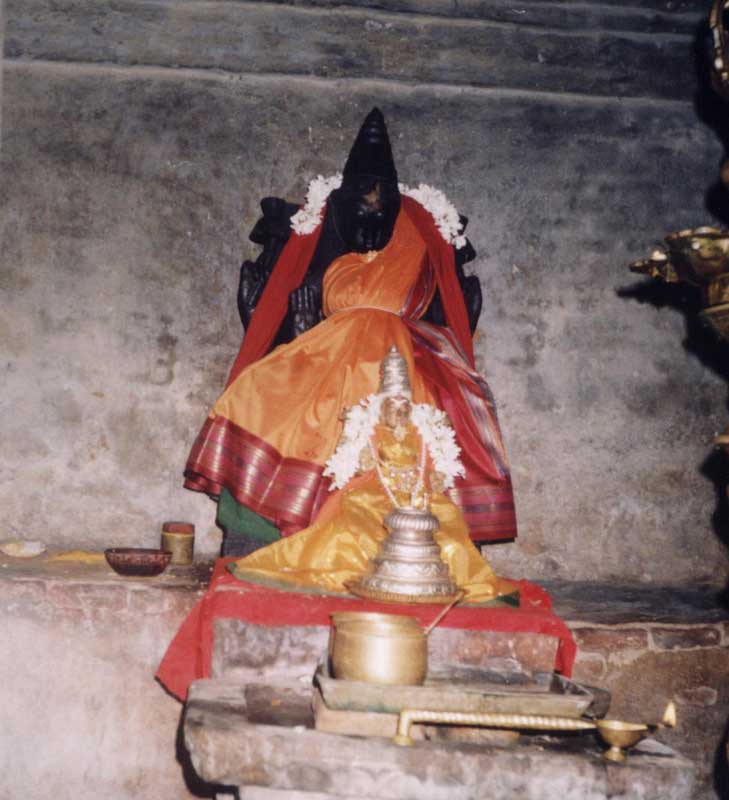
Sri Bhargavi or Sri Kamalavasini Thayar
Rithava yajugumsi samani thadhaiva aadarvananicha
sarvam ashtaksharan tasyam yasyanmati vangmayam|
An important message is conveyed in this sloka. Vedas -Rig, Yajur, Samam and Atharvanam - are all compressed in the single syllable pranavam Om [or AUM]. Just as a large banyan tree is available in a tiny seed and on growing provides shelter for many, Om contains all the Vedas. Expanding this, spreads all over. Pranavakara Om expounds the Lord and so is called vasakam. The Lord is the embodiment of Om and Om denotes Sriman Narayana. We are in the shade of the vimanam in Thiruadhanur and is called pranavakara vimanam. Today's [ 15th May 2008] lecture is from the terrace of the vimanam in the temple of Sri Aandalakkum Ayyan. Natural surroundings are a feast to the eyes. The pond next to the temple - Surya pushkarini- is full of water and filled with lotus flowers. The temple tree is Padhiri tree. We can see the beautiful temple garden and the Swarga vasal. Tall dwajasthambam can be seen. We will now see the 13th sloka of Chapter 8. We should be grateful to the Lord for studying this sloka here as it is connected with the vimanam here.
om ity ekaksharam brahma
vyaharan mam anusmaran
yah prayati tyajan deham
sa yati paramam gatim
"By continuous meditating on Me in the single syllable Om, he who is on his journey leaving body, reaches supreme position"
'He who meditates on the single syllable Om, which represents Me [Sri Krishna], and dies, his soul leaving the body will reach the Moksham of Kaivalyam', says Sri Krishna. We are seeing this sloka at the Pranavakara vimanam itself. By worshiping this vimanam we are worshiping the substance of pranavam [Sriman Narayana] and by chanting Om, we listen to the sound of pranavam. So both ears and eyes perceive the Pranavam. Once, Agni, the god of fire, had a curse and to nullify it he came to this place and worshiped the Lord.
We should remember that slokas 11,12 and 13 are meant for kaivalyarti. Brahma = Brahmam, om = pranavam, ity ek akshara = single syllable, vyaharan = chanting. Kaivalyarti has to continuously meditate on Om. Om indicates Brahmam, that is the Lord Sriman Narayana. Since Om denotes Him, it is called vasakam. Mam = Me [ Sri Krishna, denoted by the syllable Om], anusmaran = meditating. This devotee should meditate on Om as the substance of the Lord. While chanting Om, he should ponder over the meaning as conveying the Lord. The Lord is called by many divine names; but the most appropriate is the single syllable pranavam -Om. Ya prayati = he, who starts the journey [ just before casting off this body in the death bed], deham = body, tyajan = casting off, sa yati = he attains, paramam = supreme, gatim = path or position, that is kaivalyam. He reaches a position sans this prakruti and so he will have no more contacts with this body belonging to prakruti. He will have no more sufferings and pleasures arising out of papa and punya. He attains muktaatma swaroopam. He attains the atman's natural bliss. Continuing from slokas 11 and 12, the Lord tells what the kaivalyarti should meditate upon in the normal days and in the final hours of life. In the last sloka He told where the prana was to be spotted and there after he has to meditate on pranavam as the substance of the Lord uninterruptedly. According to Tamil grammar, each letter is to be pronounced in a given time and it is called mathirai [ नम]. Pranavam Om consists of three letters A [नम], U [नम ] and M [ ம் ]. A denotes the red hued lord Brahma. U denotes the black hued Lord Vishnu. M denotes the white hued lord Shiva. These constitute three mathirai. To this another half mathirai is added and then it denotes the Brahmam, Sriman Narayana. The meaning of parnava is that M denoting atman [Jeevatman] is dependent and servant of A denoting the Lord. Actually, the substance of pranavam has to be learnt from a good Acharya, after observing all formalities, and with respect. It is considered as very sacred and its meaning should not be told just like that. A denotes the Lord Vishnau and M denotes all the Jeevatman and the pranavam conveys that all the jeevatman are servants of the Lord Sri Vishnu. Here we should appreciate a subtle point. Once pranavam is properly understood, that this atman is servant of the Lord, why should anyone try to think of independence and seek kaivalyam? Therefore, there are good chances that this kaivalyarti while pondering on the substance of pranavam, might change his objective and seek the Lord Himself, instead of kaivalyam. There is yet another interpretation. Ashtaksharam is namo narayanaya [ 7 syllables ] plus pranavam, making it Eight syllable mantra. Pranavam does not convey complete substance that we are not independent and we are servants of the Lord alone. Therefore this person might seek kaivalyam. But in Ashtaksharam, nama: [ नम:] is na [ not] + ma: [mine]. That is this soul [or I] does not belong to self, but to You, Sriman Narayana. Ashtaksharam makes this meaning unambiguous and this is the reason Alwars emphasize more on Namo Narayana and not on the pranavam. So only meditating on pranavam is suited to kaivalyarti, but not for those who want to be in Vaikuntam. But it is to be remembered that even if one wants kaivalyam, it can be reached only with the help of the Lord. We will now take leave of this kshetram after conveying our grateful regards to Sri Ahobila mutt and H.H. the Jeer Azhagiyasingar.
No comments:
Post a Comment